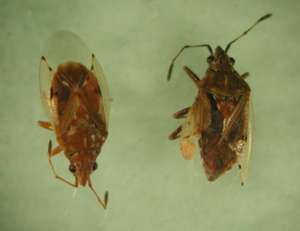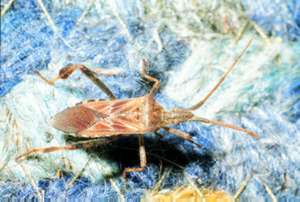 M1181
M11812004
![]()
 M1181
M1181
2004
Jeffrey Hahn, Department of Entomology, University of Minnesota Extension Service
[printer-friendly pdf version]
Many different types of insects can enter homes and buildings during late summer and fall as they search for protected sites in which to overwinter. These insects are generally harmless to people and property and do not reproduce indoors. Such insects are generally referred to as nuisance or accidental invaders.
Three nuisance invaders, birch catkin feeders, hackberry psyllids, and western conifer-seed bugs, are rarely noticed during summer when they feed on plants. However, they become more conspicuous during fall when people see them on the outside of buildings or indoors. If these insects take shelter in wall voids or cracks and spaces around buildings, they may emerge and be seen indoors during sunny, mild winter weather and again in spring.
 Birch catkin
feeders, Kleidocerys resedae (Panzer), are common on birch trees, especially
white-barked birch, during August and September. Also known as birch catkin
bugs, they have been found on azaleas, rhododendrons and other plants as well.
They feed on the seeds of their host plants; catkins, in the case of birch.
Despite this feeding, they do not harm plants and their management in landscapes
is unnecessary.
Birch catkin
feeders, Kleidocerys resedae (Panzer), are common on birch trees, especially
white-barked birch, during August and September. Also known as birch catkin
bugs, they have been found on azaleas, rhododendrons and other plants as well.
They feed on the seeds of their host plants; catkins, in the case of birch.
Despite this feeding, they do not harm plants and their management in landscapes
is unnecessary.
Identification
The birch catkin feeder is a small, 1/8th inch long, oval insect with a reddish-brown head and body. Its wings are divided into two areas: the anterior section (closest to the head) is thickened and reddish brown while the posterior half of their wings is thin and clear. If you look closely, you can also see a series of three or four black dots where the membranous section of wings meets the more thickened area. The wings are long, extending past the abdomen. Birch catkin feeders have well developed scent glands and can emit a strong, unpleasant odor.
Life Cycle
Birch catkin feeders overwinter in sheltered, protected sites such as old catkins, under leaves, and in and around buildings. During spring, adults mate and lay eggs. The nymphs, smaller less developed versions of the adults, also feed on catkins. Nymphs mature into adults by the end of summer.
These insects commonly move to the sides of buildings on sunny, warm fall days. Birch catkin feeders do not seem very interested in entering buildings, although they can inadvertently fly through open windows or hitchhike indoors on clothing or other objects. Fortunately, people usually only see a few birch catkin feeders indoors at a time and those that do get inside do not generally live long. These bugs give off a bad smell when crushed.
Management
There’s no need to treat the exterior of buildings in most, if not all, cases. Though they are active during sunny, warm fall days, these insects go away on their own as weather grows colder. Vacuum or physically remove birch catkin feeders that you find indoors.
 Hackberry
psyllids ( SIL-ids), Pachypsylla celtidivesicula Riley and P.
celtidismamma (Fletcher), are small insects that cause the galls commonly seen on hackberry
leaves. These species are specific to hackberry trees and do not develop on
any other plants. Pachypsylla celtidivesicula is responsible for hackberry
blister galls on the upper surface of leaves while P.
celtidismamma produce
hackberry nipple galls on the underside of leaves.
Hackberry
psyllids ( SIL-ids), Pachypsylla celtidivesicula Riley and P.
celtidismamma (Fletcher), are small insects that cause the galls commonly seen on hackberry
leaves. These species are specific to hackberry trees and do not develop on
any other plants. Pachypsylla celtidivesicula is responsible for hackberry
blister galls on the upper surface of leaves while P.
celtidismamma produce
hackberry nipple galls on the underside of leaves.
Psyllids are annoying simply because of their presence. They also can ‘bite’ people, although not in the same sense as a mosquito or a flea bites. They prick exposed skin as they ‘taste test,’ looking for food. Otherwise, they are harmless to people, pets, houseplants, stored products, and furnishings.
Identification
Without magnification, a psyllid appears gnat-like. It is about 1/8 - 3/16 inch long and has mottled brownish wings with small black and white spots. Its wings, held roof-like over its body, extend well past its abdomen. Psyllids, also known as jumping plant lice, can jump and fly away quickly. When examined closely, a psyllid resembles a miniature cicada.
Life Cycle
Adult psyllids emerge from overwintering sites in early spring and fly to hackberry trees to lay eggs in developing leaves. Eggs hatch into tiny nymphs that feed on the leaves. This feeding stimulates the leaves to create abnormal plant tissue that surrounds individual psyllids, resulting in the formation of galls. The psyllids live and feed inside these galls for the rest of the summer. Galls affect the appearance of the leaves but rarely harm a healthy, mature tree even when it has large numbers of them.
When psyllids complete their development in late summer, adults exit the galls to spend the winter in protected sites, such as cracks and crevices of tree bark and other sheltered locations. They are also attracted to the sunny sides of buildings and enter through cracks and spaces around windows, doors, or siding. They are small enough that they can pass through most screens and are especially common around windows. Psyllid numbers vary from year to year.
Management
Although it is possible to reduce hackberry psyllid problems by cutting down hackberry trees in your yard, this is rarely practical or desirable. Another option would be to treat your trees before galls are produced. Spray hackberry foliage during spring with a registered insecticide, such as acephate, when leaves are ½ expanded. If you treat galls later in the season, it will not kill the psyllids. Removing or spraying trees will have little effect if hackberry trees are common in your neighborhood, as the psyllids can fly into your yard from nearby areas.
Psyllids are active during warm fall weather. Install storm windows before psyllids start to fly to homes to help keep them from moving through window screens. Though psyllids can pass through most screening, using screens with an 18 mesh size will help keep out psyllids and other small insects.
Psyllids are attracted to lights at night. Keep outside lighting turned off or install lights, such as yellow lights, that are less attractive to insects. Psyllid problems resolve quickly on their own when weather becomes colder.
If necessary, you can help minimize psyllid numbers by spraying the exterior of your home with a residual insecticide. Use a product specifically labeled for the exterior of buildings, such as permethrin, deltamethrin, or bifenthrin. Spray around windows and doors.
Once you find psyllids indoors, remove them through physical means such as with a vacuum. Insecticides are not suggested for treating psyllids indoors.
 The western conifer-seed
bug, Leptoglossus occidentalis Heidemann, is a type of leaf-footed bug. These
bugs are common in small numbers in homes during fall as well as winter and
spring. They don’t bite or sting and are harmless to people and their
property.
The western conifer-seed
bug, Leptoglossus occidentalis Heidemann, is a type of leaf-footed bug. These
bugs are common in small numbers in homes during fall as well as winter and
spring. They don’t bite or sting and are harmless to people and their
property.
Identification
The western conifer-seed bug is ¾ inch long, elongate, and fairly robust. It is reddish-brown with a white zig-zag line across the center of its wings. This bug has long, conspicuous back legs with a leaf-like enlargement on them. When this insect flies, it buzzes like a bumble bee and exposes orange and black stripes on its abdomen.
Because of its large back legs, people sometimes think this bug is a grasshopper. It is also sometimes mistaken for a cockroach because of their similar size, color, and conspicuous antennae. However, it easy to distinguish between them as a cockroach moves quickly, does not fly, hides during the day, and has antennae as long or longer than its body. A western conifer-seed bug moves slowly, flies readily, is commonly seen during the day, and has antennae that extend less than half the length of its body.
Life Cycle
Nymphs and adults spend the summer on pines and Douglas firs, feeding on sap from green cones and needles. This feeding does not harm landscape trees in the Midwest. As the weather cools in September, western conifer-seed bugs search for sheltered places to hibernate. These bugs do not normally accumulate in large numbers like boxelder bugs or lady beetles but are typically seen a few at a time. It is common to see them periodically during mild days during winter and into spring.
Management
Prevent western conifer-seed bugs in your home by pest-proofing the outside of buildings. Seal cracks and spaces around doors, windows, fascia boards, and similar places as well as where utility wires and pipes enter buildings. Repair or replace damaged window and door screens along with any damaged screens in roof and soffit vents, or bathroom and kitchen fans. Install door sweeps or thresholds to all exterior entry doors. Install a rubber seal along the bottom of garage doors.
In most cases, insecticides are not necessary or justified to manage western conifer- seed bugs. Most people rarely see western conifer-seed bugs on the outside of their homes. If you find large numbers entering buildings, then supplement exclusion techniques with an insecticide application such as permethrin or bifenthrin around the exterior, paying particular attention to windows and doors.
If you find western conifer-seed bugs indoors, just remove them by physical means, such as a dustpan or vacuum. You may also see these bugs during winter and early spring, though it's unlikely you’ll see more than a few at a time. Insecticides are not necessary to treat the occasional western conifer-seed bug found indoors.
CAUTION: The label is the final authority on how you may legally use any pesticide. Read all insecticide labels very carefully before buying and again before using the products, to ensure proper application. This is especially important as the availability and recommended use of specific pesticides may change from year to year. Be sure the specific insecticide you intend to buy is labeled for the site you wish to use it in.
![]()
The information given in this publication is for educational purposes
only. Reference to commercial products or trade names is made with the
understanding that no discrimination is intended and no endorsement by the
University of Minnesota Extension Service is implied.
Produced by Communication and Educational Technology Services, University of Minnesota Extension Service.
In accordance with the Americans with Disabilities Act, this material is available in alternative formats upon request. Please contact your University of Minnesota Extension Service office or the Distribution Center at (800) 876-8636.
The University of Minnesota Extension Service is committed to the policy that all persons shall have equal access to its programs, facilities, and employment without regard to race, color, creed, religion, national origin, sex, age, marital status, disability, public assistance status, veteran status, or sexual orientation.